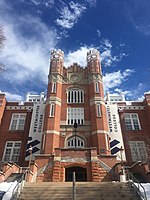Third Presbyterian Church Parsonage
Churches completed in 1890Clergy houses in the United StatesHouses in Salt Lake CityHouses on the National Register of Historic Places in UtahNational Register of Historic Places in Salt Lake City ... and 5 more
Presbyterian churches in UtahProperties of religious function on the National Register of Historic Places in UtahUtah Registered Historic Place stubsUtah church stubsVictorian architecture in Utah

Third Presbyterian Church Parsonage is a historic Presbyterian parsonage at 1068 E. Blaine Avenue in Salt Lake City, Utah. The Late Victorian, Rectangular Block building was constructed in 1890. It was added to the National Register in 2000. It is significant for association with the Third Presbyterian Church of Salt Lake City, which itself "had a significant influence on the development of the southeast bench of the city", apparently spurring and reflecting non-Mormon development. According to its NRHP nomination, the "house was built c.1890 but its significance dates from 1912-1929 when it was owned by the church and served as the minister's residence."
Excerpt from the Wikipedia article Third Presbyterian Church Parsonage (License: CC BY-SA 3.0, Authors, Images).Third Presbyterian Church Parsonage
1100 East, Salt Lake City
Geographical coordinates (GPS) Address Nearby Places Show on map
Geographical coordinates (GPS)
| Latitude | Longitude |
|---|---|
| N 40.732222222222 ° | E -111.85972222222 ° |
Address
1100 East 1760
84105 Salt Lake City
Utah, United States
Open on Google Maps









